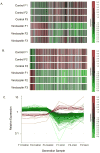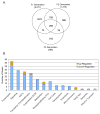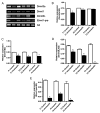Transgenerational epigenetic programming of the embryonic testis transcriptome
- PMID: 18042343
- PMCID: PMC2239263
- DOI: 10.1016/j.ygeno.2007.10.002
Transgenerational epigenetic programming of the embryonic testis transcriptome
Abstract
Embryonic exposure to the endocrine disruptor vinclozolin during gonadal sex determination appears to promote an epigenetic reprogramming of the male germ line that is associated with transgenerational adult-onset disease states. Transgenerational effects on the embryonic day 16 (E16) testis demonstrated reproducible changes in the testis transcriptome for multiple generations (F1-F3). The expression of 196 genes was found to be influenced, with the majority of gene expression being decreased or silenced. Dramatic changes in the gene expression of methyltransferases during gonadal sex determination were observed in the F1 and F2 vinclozolin generation (E16) embryonic testis, but the majority returned to control-generation levels by the F3 generation. The most dramatic effects were on the germ-line-associated Dnmt3A and Dnmt3L isoforms. Observations demonstrate that an embryonic exposure to vinclozolin appears to promote an epigenetic reprogramming of the male germ line that correlates with transgenerational alterations in the testis transcriptome in subsequent generations.
Conflict of interest statement
Disclosure: None of the authors have a financial or conflict of interest to disclose
Figures





References
-
- Gluckman PD, Hanson MA. Developmental origins of disease paradigm: a mechanistic and evolutionary perspective. Pediatr Res. 2004;56:311–7. - PubMed
-
- Li E. Chromatin modification and epigenetic reprogramming in mammalian development. Nat Rev Genet. 2002;3:662–73. - PubMed
-
- Jiang YH, Bressler J, Beaudet AL. Epigenetics and human disease. Annu Rev Genomics Hum Genet. 2004;5:479–510. - PubMed
-
- Egger G, Liang G, Aparicio A, Jones PA. Epigenetics in human disease and prospects for epigenetic therapy. Nature. 2004;429:457–63. - PubMed
Publication types
MeSH terms
Substances
Grants and funding
LinkOut - more resources
Full Text Sources
Medical
Molecular Biology Databases
Miscellaneous

